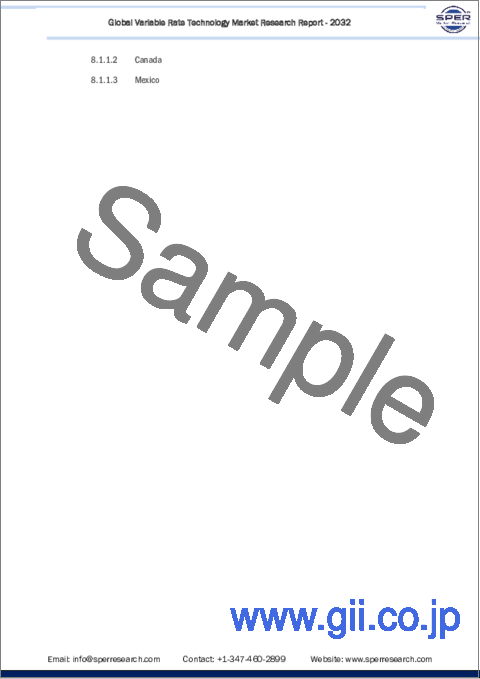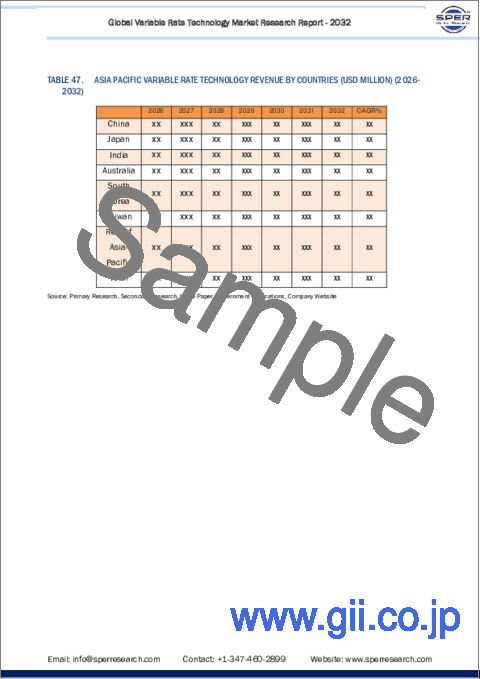|
|
市場調査レポート
商品コード
1182447
可変作業技術(VRT)の世界市場:市場規模 - コンポーネント別、技術別、作物タイプ別、農場規模別、用途別、地域別展望、競合戦略、セグメント別予測(~2032年)Variable Rate Technology Market Size- By Component, By Technology, By Crop Type, By Farm Size, By Application- Regional Outlook, Competitive Strategies and Segment Forecast to 2032 |
||||||
| 可変作業技術(VRT)の世界市場:市場規模 - コンポーネント別、技術別、作物タイプ別、農場規模別、用途別、地域別展望、競合戦略、セグメント別予測(~2032年) |
|
出版日: 2022年12月26日
発行: SPER Market Research Pvt. Ltd.
ページ情報: 英文 245 Pages
納期: 即日から翌営業日
|
- 全表示
- 概要
- 目次
世界の可変作業技術(VRT)の市場規模は、2032年までに260億7,000万米ドルに達し、CAGRで13.42%の成長が予測されています。
最先端の農業ソリューションの利用が拡大していることは、可変作業技術(VRT)供給企業の成長機会を高めています。競合企業は、生産量を増やすために使用される機械の技術的進歩を利用することで、農業用可変作業市場における地位を向上させることができます。
当レポートでは、世界の可変作業技術(VRT)市場について調査し、市場力学、市場変数と展望、競合情勢、コンポーネント・技術・作物タイプ・農場規模・用途・地域別の市場分析、企業プロファイル等に関する情報を提供しています。
目次
第1章 イントロダクション
- 調査範囲
- 市場セグメント分析
第2章 調査手法
- 調査データソース
- 市場規模の推定
- データの三角測量
第3章 エグゼクティブサマリー
第4章 市場力学
- 促進要因、抑制要因、機会、課題の分析
- 促進要因
- 抑制要因
- 機会
- 課題
- 世界の可変作業技術(VRT)市場におけるCOVID-19の影響
第5章 市場変数と展望
- SWOT分析
- 強み
- 弱み
- 機会
- 脅威
- PESTEL分析
- 政治情勢
- 経済情勢
- 社会情勢
- 技術情勢
- 環境情勢
- 法的情勢
- ポーターのファイブフォース分析
- 供給企業の交渉力
- 買い手の交渉力
- 代替品の脅威
- 新規参入者の脅威
- 競合企業間の敵対関係
- ヒートマップ分析
第6章 競合情勢
- 世界の可変作業技術(VRT)の製造拠点流通、販売エリア、製品タイプ
- 世界の可変作業技術(VRT)市場における合併・買収、パートナーシップ、製品の発売、コラボレーション
第7章 世界の可変作業技術(VRT)市場:コンポーネント別(2019年~2032年、100万米ドル)
- ハードウェア
- ガイダンス・ステアリングシステム
- フロー・アプリケーション制御デバイス
- GPS/DGPSレシーバー
- ハンドヘルドモバイルデバイス/コンピューター
- 収量モニター
- その他
- サービス
- 農場運営サービス
- 統合・コンサルティングサービス
- ソフトウェア
第8章 世界の可変作業技術(VRT)市場:技術別(2019年~2032年、100万米ドル)
- マップベース
- センサーベース
- アクティブ光学センサーVRT
- ドローンベースVRT
- 衛星ベースVRT
第9章 世界の可変作業技術(VRT)市場:作物タイプ別(2019年~2032年、100万米ドル)
- 穀物・穀類
- トウモロコシ
- 小麦
- その他
- 果物・野菜
- 油糧種子・豆類
- 大豆
- 綿花
- その他
- その他
第10章 世界の可変作業技術(VRT)市場:農場規模別(2019年~2032年、100万米ドル)
- 大規模農場
- 中規模農場
- 小規模農場
第11章 世界の可変作業技術(VRT)市場:用途別(2019年~2032年、100万米ドル)
- 肥料
- 尿素VRT
- UAN VRT
- NH3 VRT
- その他のVRT
- 作物保護化学品
- 除草剤
- 殺菌剤
- 殺虫剤
- 殺線虫剤・その他
- 土壌センシング
- 収量モニタリング
- 灌漑
- その他
第12章 世界の可変作業技術(VRT)市場:地域別(2019年~2032年、100万米ドル)
- 世界の可変作業技術(VRT)の市場規模・市場シェア:地域別(2019年~2025年)
- 世界の可変作業技術(VRT)の市場規模・市場シェア:地域別(2026年~2032年)
- アジア太平洋
- オーストラリア
- 中国
- インド
- 日本
- 韓国
- その他のアジア太平洋
- 欧州
- フランス
- ドイツ
- イタリア
- スペイン
- 英国
- その他の欧州
- 中東・アフリカ
- サウジアラビア王国
- アラブ首長国連邦
- その他の中東・アフリカ
- 北米
- カナダ
- メキシコ
- 米国
- 南米
- アルゼンチン
- ブラジル
- その他の南米
第13章 企業プロファイル
- AGCO Corporation
- 企業概要
- 財務展望
- 製品概要
- 最近の開発
- AgJunction
- CNH Industrial NV
- Deere & Company
- Hexagon
- Kubota Corporation
- Lindsay Corporation
- Topcon Corporation
- Trimble Inc.
- Valmont Industries, Inc.
- Yara International
第14章 略語一覧
第15章 参照リンク
第16章 結論
第17章 調査範囲
Global Variable Rate Technology Market Overview:
According to SPER Market Research, the Global Variable Rate Technology Market is estimated to reach USD 26.07 billion by 2032 with a CAGR of 13.42%.
The agricultural variable rate technology market consists of sales of agricultural variable rate technology made by organizations, individuals, and partnerships. With a focus on the automated applications utilized in agriculture, this technological area deals with automated applications. Information about agriculture is gathered via sensors, maps, and GPS. Farmers can use a tool called Variable Rate Technology (VRT) to apply water, fertilizer, seed, and pesticides to different parts of a field at various rates. One can get more crop per acre of land while using less wasted material when they utilize VRT to apply the right number of fertilizers together with the right sowing rate. The rising usage of these cutting-edge agricultural solutions has increased the growth opportunities for VRT suppliers. Competitors can improve their positions in the agriculture variable rate market by taking advantage of technological advancements in the machinery used to increase output. The automation of farming practices will increase as technology advances. The use of VRT will rise with the use of sensors, images, control systems, data management, big data, and AI, supporting new rivals in gaining a footing in the market.
Impact of COVID-19 on the Global Variable Rate Technology Market:
The need for agricultural equipment and related technology has temporarily diminished due to the COVID-19 pandemic epidemic. Because VRT requires little employee involvement and labor prices are rising daily, the agriculture variable rate technology industry has recovered since the epidemic. The pandemic's acute labor shortage, which had a negative impact on overall production, forced farmers to learn the benefits of investing in technologies rather than relying on workers. Using variable rate technology in agriculture is a great approach to get around these problems. COVID-19 has had a positive long-term impact on the target market since it helped farmers comprehend the financial benefits of investing in variable rate technology. Western Europe and North America are home to the majority of agriculture technology companies. These areas were severely affected by COVID-19, and economic activity was at its lowest point as a result of the temporary shutdown and quarantine measures taken to combat the fatal COVID-19 epidemic.
Scope of the Report:
- Market size available for years: 2019-2032
- Base year considered: 2021
- Forecast period: 2022-2032
- Segments covered: By Component, By Technology, By Crop Type, By Farm Size, By Application
- Regions covered: North America, Europe, Asia Pacific, Latin America, Middle East and Africa
- Companies Covered: AGCO Corporation, AgJunction, CNH Industrial NV, Deere & Company, Hexagon, Kubota Corporation, Lindsay Corporation, Topcon Corporation, Trimble Inc., Valmont Industries, Inc., Yara International
Target Audience:
- Growers or farmers
- Agriculture variable rate technology manufacturers
- OEMS
- Component suppliers
- Dealers
- Service providers
- Government and Research Organizations
- Associations
- Regulatory bodies
Global Variable Rate Technology Market Segmentation:
- By Component: Based on the Component, Global Variable Rate Technology Market is segmented as; Hardware (Guidance and Steering systems, Flow and Application Control Devices, GPS/DGPS Receivers, Handheld Mobile Devices/Computers, Yield Monitors, Others), Services (Farm Operation Service, Integration and Consultation Services), Software.
- By Technology: Based on the Technology, Global Variable Rate Technology Market is segmented as; Map-based, Sensor-based (Active Optical Sensor VRT, Drone-based VRT, Satellite-based VRT).
- By Crop Type: Based on the Crop Type, Global Variable Rate Technology Market is segmented as; Cereals and Grains (Corn, Wheat, Others), Fruits and Vegetables, Oilseeds and Pulses (Soybeans, Cotton, Other), Others.
- By Farm Size: Based on the Farm Size, Global Variable Rate Technology Market is segmented as; Large Farms, Mid-Sized Farms, Small Farms.
- By Application: Based on the Application, Global Variable Rate Technology Market is segmented as; Fertilizers (Urea VRT, UAN VRT, NH3 VRT, Other VRT), Crop Protection Chemicals (Herbicides, Fungicides & Bactericides, Insecticides, Nematicides & Others), Soil Sensing, Yield Monitoring, Irrigation, Others.
- By Region: The overall market was topped by North America. North America currently controls the majority of the global market for variable rate technology because of the region's tremendous progress in the automation and digitization of agriculture. Agriculture is becoming more industrialized and digitalized, which is creating new industry standards for the agricultural VRT market. Due to increased crop use, the VRT market in North America is developing each year. The fastest CAGR is anticipated to occur in Asia Pacific. It is anticipated that the Asia Pacific region's vast farmlands and quick population growth will lead to the rapid growth of VRT in the future. Given the huge farmlands and rapid population increase, it is one of the potential markets for agriculture VRT. The Asia Pacific region has a huge landmass and includes nations like Japan, China, South Korea, India, and Australia. The region's emerging nation's growing populations put pressure on agriculture to raise output, which fuels demand for VRT (Variable Rate Technologies).
Table of Contents
1. Introduction
- 1.1. Scope of the report
- 1.2. Market segment analysis
2. Research Methodology
- 2.1 Research data source
- 2.1.1 Secondary data
- 2.1.2 Primary data
- 2.1.3 SPER's internal database
- 2.1.4 Premium insight from KOL's
- 2.2 Market size estimation
- 2.2.1 Top-down and Bottom-up approach
- 2.3 Data triangulation
3. Executive Summary
4. Market Dynamics
- 4.1. Driver, Restraint, Opportunity and Challenges analysis
- 4.1.1 Drivers
- 4.1.2 Restraints
- 4.1.3 Opportunities
- 4.1.4 Challenges
- 4.2. COVID-19 Impacts of the Global Variable Rate Technology Market
5. Market variables and outlook
- 5.1. SWOT analysis
- 5.1.1 Strengths
- 5.1.2 Weaknesses
- 5.1.3 Opportunities
- 5.1.4 Threats
- 5.2. PESTEL analysis
- 5.2.1 Political landscape
- 5.2.2 Economic landscape
- 5.2.3 Social landscape
- 5.2.4 Technological landscape
- 5.2.5 Environmental landscape
- 5.2.6 Legal landscape
- 5.3. PORTER'S five forces analysis
- 5.3.1 Bargaining power of suppliers
- 5.3.2 Bargaining power of Buyers
- 5.3.3 Threat of Substitute
- 5.3.4 Threat of new entrant
- 5.3.5 Competitive rivalry
- 5.4. Heat map analysis
6. Competitive Landscape
- 6.1 Global Variable Rate Technology Manufacturing Base Distribution, Sales Area, Product Type
- 6.2 Mergers & Acquisitions, Partnerships, Product Launch, and Collaboration in Global Variable Rate Technology Market
7. Global Variable Rate Technology Market, By Component, 2019-2032 (USD Million)
- 7.1 Hardware
- 7.1.1 Guidance and Steering systems
- 7.1.2 Flow and Application Control Devices
- 7.1.3 GPS/DGPS Receivers
- 7.1.4 Handheld Mobile Devices/Computers
- 7.1.5 Yield Monitors
- 7.1.6 Others
- 7.2 Services
- 7.2.1 Farm Operation Service
- 7.2.2 Integration and Consultation Services
- 7.3 Software
8. Global Variable Rate Technology Market, By Technology, 2019-2032 (USD Million)
- 8.1 Map-based
- 8.2 Sensor-based
- 8.2.1 Active Optical Sensor VRT
- 8.2.2 Drone-based VRT
- 8.2.3 Satellite-based VRT
9. Global Variable Rate Technology Market, By Crop Type, 2019-2032 (USD Million)
- 9.1 Cereals and Grains
- 9.1.1 Corn
- 9.1.2 Wheat
- 9.1.3 Others
- 9.2 Fruits and Vegetables
- 9.3 Oilseeds and Pulses
- 9.3.1 Soybeans
- 9.3.2 Cotton
- 9.3.3 Other
- 9.4 Others
10. Global Variable Rate Technology Market, By Farm Size, 2019-2032 (USD Million)
- 10.1 Large Farms
- 10.2 Mid-Sized Farms
- 10.3 Small Farms
11. Global Variable Rate Technology Market, By Application, 2019-2032 (USD Million)
- 11.1 Fertilizers
- 11.1.1 Urea VRT
- 11.1.2 UAN VRT
- 11.1.3 NH3 VRT
- 11.1.4 Other VRT
- 11.2 Crop Protection Chemicals
- 11.2.1 Herbicides
- 11.2.2 Fungicides & Bactericides
- 11.2.3 Insecticides
- 11.2.4 Nematicides & Others
- 11.3 Soil Sensing
- 11.4 Yield Monitoring
- 11.5 Irrigation
- 11.6 Others
12. Global Variable Rate Technology Market, By Region, 2019-2032 (USD Million)
- 12.1 Global Variable Rate Technology Size and Market Share by Region (2019-2025)
- 12.2 Global Variable Rate Technology Size and Market Share by Region (2026-2032)
- 12.3 Asia-Pacific
- 12.3.1 Australia
- 12.3.2 China
- 12.3.3 India
- 12.3.4 Japan
- 12.3.5 South Korea
- 12.3.6 Rest of Asia-Pacific
- 12.4 Europe
- 12.4.1 France
- 12.4.2 Germany
- 12.4.3 Italy
- 12.4.4 Spain
- 12.4.5 United Kingdom
- 12.4.6 Rest of Europe
- 12.5 Middle East & Africa
- 12.5.1 Kingdom of Saudi Arabia
- 12.5.2 United Arab Emirates
- 12.5.3 Rest of Middle East & Africa
- 12.6 North America
- 12.6.1 Canada
- 12.6.2 Mexico
- 12.6.3 United States
- 12.7 South America
- 12.7.1 Argentina
- 12.7.2 Brazil
- 12.7.3 Rest of South America
13. Company Profiles
- 13.1 AGCO Corporation
- 13.1.1 Company details
- 13.1.2 Financial outlook
- 13.1.3 Product summary
- 13.1.4 Recent developments
- 13.2 AgJunction
- 13.2.1 Company details
- 13.2.2 Financial outlook
- 13.2.3 Product summary
- 13.2.4 Recent developments
- 13.3 CNH Industrial NV
- 13.3.1 Company details
- 13.3.2 Financial outlook
- 13.3.3 Product summary
- 13.3.4 Recent developments
- 13.4 Deere & Company
- 13.4.1 Company details
- 13.4.2 Financial outlook
- 13.4.3 Product summary
- 13.4.4 Recent developments
- 13.5 Hexagon
- 13.5.1 Company details
- 13.5.2 Financial outlook
- 13.5.3 Product summary
- 13.5.4 Recent developments
- 13.6 Kubota Corporation
- 13.6.1 Company details
- 13.6.2 Financial outlook
- 13.6.3 Product summary
- 13.6.4 Recent developments
- 13.7 Lindsay Corporation
- 13.7.1 Company details
- 13.7.2 Financial outlook
- 13.7.3 Product summary
- 13.7.4 Recent developments
- 13.8 Topcon Corporation
- 13.8.1 Company details
- 13.8.2 Financial outlook
- 13.8.3 Product summary
- 13.8.4 Recent developments
- 13.9 Trimble Inc.
- 13.9.1 Company details
- 13.9.2 Financial outlook
- 13.9.3 Product summary
- 13.9.4 Recent developments
- 13.10 Valmont Industries, Inc.
- 13.10.1 Company details
- 13.10.2 Financial outlook
- 13.10.3 Product summary
- 13.10.4 Recent developments
- 13.11 Yara International
- 13.11.1 Company details
- 13.11.2 Financial outlook
- 13.11.3 Product summary
- 13.11.4 Recent developments




